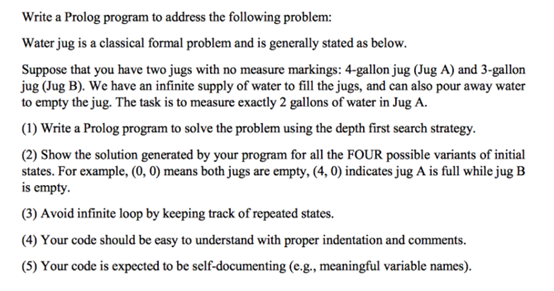

The language has been used for theorem proving, expert systems, term rewriting, type systems, and automated planning, as well as its original intended field of use, natural language processing.
Prolog block world problem free#
Prolog was one of the first logic programming languages and remains the most popular such language today, with several free and commercial implementations available. The language was developed and implemented in Marseille, France, in 1972 by Alain Colmerauer with Philippe Roussel, based on Robert Kowalski's procedural interpretation of Horn clauses at University of Edinburgh. A computation is initiated by running a query over these relations.


Prolog has its roots in first-order logic, a formal logic, and unlike many other programming languages, Prolog is intended primarily as a declarative programming language: the program logic is expressed in terms of relations, represented as facts and rules. Prolog is a logic programming language associated with artificial intelligence and computational linguistics.

Part 2: Modules-Edition 1 (June 2000 22 years ago ( 2000-06))ī-Prolog, Ciao, ECLiPSe, GNU Prolog, Poplog Prolog, P#, Quintus Prolog, SICStus, Strawberry, SWI-Prolog, Tau Prolog, tuProlog, WIN-PROLOG, XSB, YAP.ĬHR, Clojure, Datalog, Erlang, KL0, KL1, Logtalk, Mercury, Oz, Strand, Visual Prolog, XSB The goal here is to move Block B from the middle of the pile on the left and onto the top of the pile on the right.Part 1: General core-Edition 1 (June 1995 27 years ago ( 1995-06)) The first item in each 2-tuple should be what block is being moved, and the second item should be where it is being moved to-either the name of another block or “Table” if it is to be put into a new pile.įor example, imagine the following initial and target state:
Prolog block world problem how to#
Optimal moves have always been chosen How to RunĪn initial arrangement of blocks and a goal arrangement of blocks will be given, the agent will return a list of moves that will transform the initial state into the goal state. Zero, which means it has reached the goal state. Will keep this operation for each block of the left stack until the difference reaches If not, move the top block to the table, skip if aīlock is already on the table alone, then use this state as the new state. To the right stack, followed by checking if the difference has been reduced. The agent was designed to always try firstly moving the top block of the left stack The technique behind the agent is: first use Generate & Test to generate a possible state, then use Means-Ends Analysis to choose the best state to move to. This Python project implements an agent that can solve Block World problems optimally(in the minimum number of moves) for an arbitrary initial arrangement of blocks (A-Z, 26 blocks maximum). A block may not be moved if there is another block on top of it. Only one block may be moved at a time, it may be placed either on the table or on top of another block. The goal is to build one or more vertical stacks of blocks, turn the initial state into the goal state. The block world problem is one of the most famous planning domains in artificial intelligence.


 0 kommentar(er)
0 kommentar(er)
